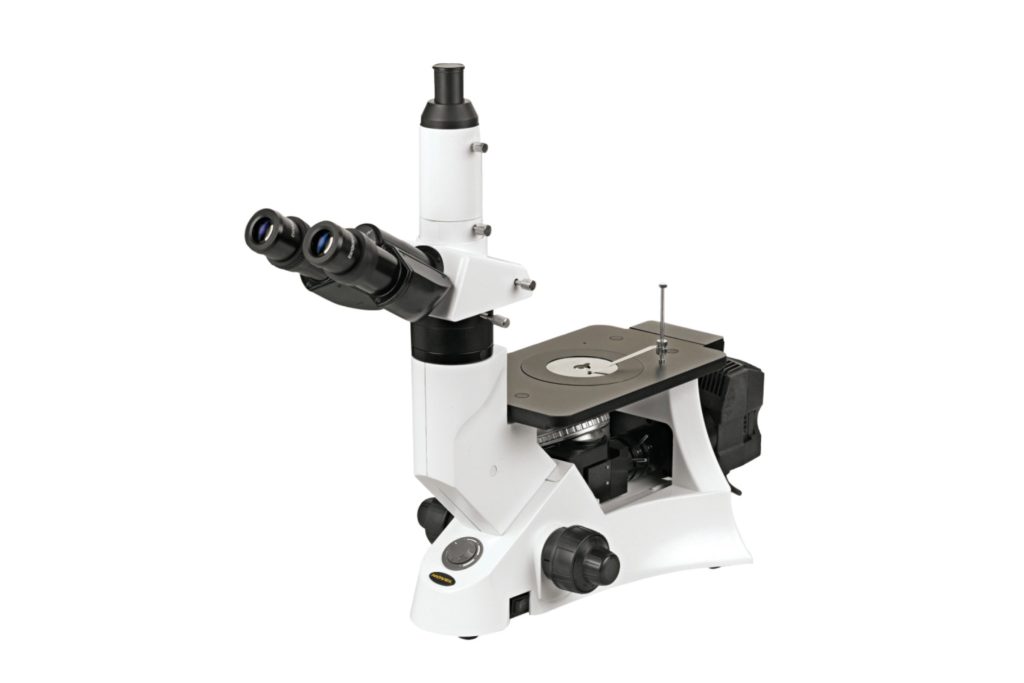What is an Inverted Metallurgical Microscope?
Metallurgical microscopes are broadly categorized into two types based on their design and orientation: upright metallurgical microscopes and inverted metallurgical microscopes.

Inverted metallurgical microscopes are equipped with a reflective illumination system suitable for observing metal materials. The term “inverted” is used because the objective lens is located below the specimen stage, requiring the workpiece to be inverted for observation on the stage.
Inverted metallurgical microscopes employ optical flat imaging to identify and analyze the microstructures of various metals and alloys. They play a crucial role in the metallographic analysis of materials in industries such as mining, metallurgy, manufacturing, and machining. These microscopes are key equipment for quality identification and analysis of castings, smelting, and heat-treated materials.
On the other hand, upright metallurgical microscopes can be equipped with both transmitted and reflected illumination systems. They are versatile and can be used to observe a variety of materials such as plastics, rubber, circuit boards, thin films, semiconductors, and metals. Therefore, they are often referred to as multifunctional metallurgical microscopes.
Choosing Between Inverted and Upright Metallurgical Microscopes
For users unfamiliar with metallurgical microscopes, the decision between an inverted or upright microscope might be unclear:
For metal materials: Inverted metallurgical microscopes are suitable as they only need to observe one surface, and the specimen has no height restrictions. In contrast, upright metallurgical microscopes require high parallelism between the two sides of the specimen and have a height limit of 30mm.
Examples: Industries such as heat treatment, casting, metal production, and machining often find inverted metallurgical microscopes a wise choice.
Applications of Inverted Metallurgical Microscopes
Inverted microscopes find wide applications in the steel, automotive, electronics, and other manufacturing industries. They are used to inspect polished metals and sectioned samples, with the sample placed inverted on the stage. The sample’s bottom does not require flat processing, and it can have larger dimensions, thickness, or weight.
Advantages of the NIM-100 Inverted Metallurgical Microscope
The NIM-100 inverted metallurgical microscope offers the following advantages:
- Infinite optical system providing excellent optical performance.
- Capable of observing and identifying the organizational structures of various metals and alloys.
- The comfortable and stable microscope body structure, efficient and convenient stage design, and easy and quick operation make it suitable for long-term use in school laboratories and industrial testing.

Technical Specifications of the NIM-100 Inverted Metallurgical Microscope
| Observation head | Trinocular observation head, 30° tilt, interpupillary distance 48-75mm | |
| Eyepieces | High eye point, extra wide field of view eyepieces EW10X/20 | |
| Infinite far-field objective lens | 2.5X/0.08/∞/- | WD 11.7mm |
| 2.5X/0.08/∞/- | WD 10.7mm(Lambda Plate) | |
| 4X/0.1/∞/- | WD 28mm | |
| 5X/0.12/∞/- | WD 15.4mm | |
| 10X/0.25/∞/- | WD 10mm | |
| 20X/0.4/∞/0 | WD 5.8mm | |
| 40X/0.6/∞/0 | WD 2.90mm | |
| 50X/0.75/∞/0 | WD 0.32mm | |
| 100X/0.80/∞/0 | WD 2mm | |
| Converter | Five-hole converter | |
| Object stage | Flat specimen stage with pressure plate | |
| Mechanical moving scale, with coaxial knobs for X and Y directions at the lower right hand, with a movement range of 120X78mm | ||
| Rectangular double-layer adjustable platform of 226X178mm, with a movement range of 50X50mm* | ||
| Extension support plate included | ||
| Focusing System | Coaxial coarse and fine focusing mechanism, focusing is achieved by the up and down movement of the converter. The coarse focusing range is 37.7mm per rotation, and the fine focusing range is 0.2mm per rotation. | |
| Illumination | 6V/30W Halogen lamp, Koehler illumination. | |
| Filter | Blue, yellow, green, ground glass filters. | |
| Polarization | ||
| Photography | ||
| Camera Interface | Standard C interface | |